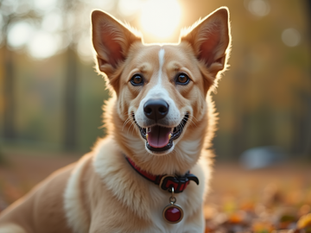
Uncovering The Best Ways to Protect Your Pup from Frigid Winter Temperatures
Jan 8
4 min read
0
16
0
As winter approaches, pet owners face unique challenges in keeping their furry friends comfortable and safe. The drop in temperature can lead to serious health risks for dogs,

Understanding the Risks of Winter Weather
When winter arrives, many dog owners may underestimate the dangers it brings. Just as humans feel the bite of cold, dogs can also be at risk if not properly cared for. Small breeds, short-haired dogs, and senior pups are especially vulnerable.
Frostbite can affect sensitive areas such as the ears, tails, and paws. Studies show that dogs can start showing signs of hypothermia when exposed to temperatures below 32°F (0°C) for extended periods. Always monitor your dog closely during cold outings to prevent these potentially life-threatening conditions.
Dressing Your Dog for the Cold
One of the simplest yet most effective ways to ensure your pup’s safety is to dress them appropriately for winter weather. Investing in a well-fitted dog sweater or coat can make a significant difference. Look for outerwear made from materials that provide insulation while repelling moisture.
Tips for Choosing the Right Winter Apparel:
Size Matters: A snug yet comfortable fit helps trap body heat. Measure your dog’s neck, chest, and length to get the best size.
Consider the Length: If your dog has a longer torso, a coat that covers their belly will help keep them warm.
Water Resistance: Choose waterproof options if your area sees snow or rain over 5 inches during winter months.
Dressing your dog appropriately not only keeps them warm but also allows them to strut in style!
Protecting Their Paws
Your dog’s paws are particularly vulnerable to winter conditions. Cold surfaces can lead to discomfort, and ice can cause injuries. Here are essential tips for protecting your pup's paws in the chill:
Booties Are Beneficial: Investing in dog booties can help insulate their paws and provide traction on slippery surfaces. Many options now also feature reflective materials for visibility.
Paw Wax: If booties aren’t suitable, applying paw wax creates a protective barrier against the cold and rough surfaces.
Frequent Checks: After each walk, inspect your dog’s paws for any injuries, salt irritation, or ice build-up.
These precautions can help make every outdoor adventure enjoyable for both you and your dog.
Creating a Safe Outdoor Environment
When your dog needs to relieve themselves or play outside, ensure that your yard is safe. Here are some key measures to consider:
Remove Hazards: Clear your yard of snow and ice to prevent slipping. Also, be vigilant for any sharp objects that could be hidden under the snow.
Limit Exposure: In extreme cold, limit outdoor time to quick bathroom breaks instead of long play sessions. Aim for 5-10 minute trips in temperatures below 20°F (-7°C).

Provide Shelter: If your dog spends significant time outside, they should have access to a well-insulated and dry shelter, preferably elevated off the ground to avoid moisture.
Following these steps will enhance outdoor safety and reduce risks associated with frigid weather.
Diet and Hydration Needs
Dogs may need dietary adjustments during winter to maintain their energy and warmth. Increased activity can boost their caloric needs.
Here’s how to adjust their diet for winter:
High-Quality Food: Look for high-quality dog food that contains at least 20% protein and 8% fat, which helps in heat generation.
Hydration: Water intake is crucial, even in colder months. Encourage your dog to drink regularly, as they may not be as inclined to do so in winter.
Warm Treats: Serving warm food or treats occasionally can help maintain their internal warmth.
Maintaining a balanced diet ensures your pup stays healthy and energetic throughout the winter months.

Monitoring Health
Winter can exacerbate specific health issues in dogs, such as arthritis and joint pain. Regular monitoring of your dog’s health during this season is essential.
Regular Vet Visits: Schedule veterinary check-ups to catch any health concerns early. Your vet can offer tailored advice based on your dog's health history.
Daily Observations: Watch for changes in behavior, energy levels, and mobility. A drop in activity may indicate discomfort or illness.
Warm-Up Periods: Particularly for older dogs or those with existing health issues, allow time for a warm-up before and after walks to ease their joints.
Taking these steps to monitor your dog will prevent small concerns from escalating into significant health issues.
Preparation Before Going Outside
Before stepping out into the cold, a few preparations can help ensure your pup’s safety. Here’s a quick checklist to consider:
Always leash your dog to avoid distractions that could lead to accidents.
Check local weather conditions and avoid outings during extreme cold or snow storms.
Plan your route in advance, steering clear of areas that may pose hazards, such as icy sidewalks or poorly lit paths.
With careful planning, outdoor ventures can remain safe and enjoyable throughout winter.
Keeping Your Pup Safe
Ensuring your dog’s safety in winter temperatures involves a thoughtful approach to clothing, paw protection, nutrition, and health monitoring. Making these adjustments to your dog care routine fosters a warm and secure environment that both you and your furry friend can enjoy.
By taking these proactive steps, you not only protect your pup but also make winter outings more fun and memorable. With the right care and attention, you can turn chilly days into cherished moments alongside your beloved dog.





